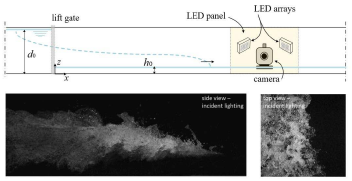ERCOFTAC PC Netherlands
The Perpetual Motion of Air and Water: A Mesmerizing Dance of Turbulence
Dorette Regout
(PhD candidate at Delft University of Technology Department of Hydraulic Engineering)
Fluid motion at its most artistic! This video captures the striking turbulent multiphase flow of the breaking roller in dam-break waves and is part of an extensive dataset from an experimental study conducted at Delft University of Technology. Dam-break waves are highly unsteady, translatory waves characterized by a breaking front with a strongly recirculating mixture of air and water. The high air content significantly influences hydrodynamic behavior, leading to dynamic free-surface deformations visualized by the foamy structures, droplets, splashes, air pockets, and bubble clusters that evolve rapidly in the upper part of the roller. Below the surface, entrapped air pockets break into smaller bubbles within the developed shear layer and are advected downstream in swirling vortices, resulting in this mesmerizing flow pattern.
Regout, D., Jonkman, S.N., Wüthrich, D., 2025. Experimental study of air–water flow properties in the breaking roller of dam-break waves. Int. J. Multiph. Flow. 185. https://doi.org/10.1016/j.ijmultiphaseflow.2024.105119
Scientific abstract
Dam-break waves are highly unsteady and violent, translatory waves characterized by a breaking front with a strongly recirculating mixture of air and water. They have been studied for decades and serve as analogies for phenomena like tsunamis, impulse waves, storm surges, and flash floods. While high levels of aeration significantly affects hydrodynamics, the multiphase nature of the breaking roller remains poorly understood as data collection is hindered by the complexity of experimental instrumentations in multiphase flows. Understanding these dynamic processes is, however, crucial for assessing wave-impact loads on coastal and hydraulic structures, and validating numerical models.
The submitted video is part of an extensive dataset collected during an experimental study conducted at the Delft University of Technology. The study aimed to investigate the multiphase nature of dam-break waves over wet beds, generated in a large flume with glass sidewalls using a pneumatic lift gate. The sudden release of the large impounded water volume triggers a breaking process, resulting in this energetic wave propagating downstream, characterized by rolling motion and continuous air entrainment (see figure). A dataset of 240 videos, including both top- and side-view perspectives, was obtained using an ultra-high-speed camera. The camera captured images at a resolution of 1024×1024 pixels at 16,000 fps, allowing for highly detailed visualization of the turbulent flow under various lighting conditions. Incident lighting, provided by two LED arrays on either side of the camera, enhanced the visibility of aerated region within the roller (see figure). Meanwhile, transmitted lighting from an LED panel positioned against the opposite glass wall accentuated surface fluctuations through inverse contrast, as shown in the submitted video. The striking turbulent recirculating flow pattern is vividly illustrated through free-surface deformations and (de-)aeration processes that dominate the roller’s upper part, generating rapidly evolving foamy structures, including droplets, splashes, air pockets, and bubble clusters (Wüthrich, 2021). In the lower part, entrapped air pockets break into smaller bubbles within the developing shear layer, generating turbulent structures associated with Kelvin–Helmholtz instabilities, visualized by the beautiful ‘dancing and swirling’ bubbly vortices. A complementary study on the dam-break waves characterized this upper recirculating zone and lower shear layer, linking void fraction profiles across the roller using phase-detection conductivity probes (Regout, 2025). This highlights the effects of air presence on the hydrodynamic behavior of the breaking roller.
Ongoing analysis of the videos include image processing techniques regarding edge detection and bubble segmentation. Intermediate results show free surface fluctuations depend on variations in Froude and Reynolds numbers, highlighting the complex interplay between gravitation and turbulent processes. Due to the unsteadiness of the flow, data analysis relies on ensemble averaging, requiring a significant number of repetitions for statistical reliability. Conducting the experimental study was therefore highly labor-intensive and limited the use of intrusive instruments to an Eulerian reference frame. The video-based non-intrusive approach enables analysis in both Eulerian and Lagrangian frames, providing novel insights into the multiphase nature of dam-break wave hydrodynamics.

Recent publications
1. Regout, D., Jonkman, S.N., Wüthrich, D., 2025. Experimental study of air–water flow properties in the breaking roller of dam-break waves. Int. J. Multiph. Flow. 185.
2. Wüthrich, D., Shi, R., Chanson, H., 2021. Strong free-surface turbulence in breaking bores: A physical study on the free-surface dynamics and air-water interfacial features. J. Fluid Mech. 924.
